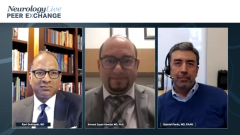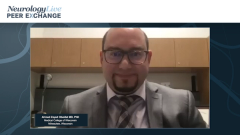
Treatment Selection in RRMS
Experts in neurology highlight factors that lead them to choose certain therapies to treat relapsing remitting multiple sclerosis (RRMS), such as high efficacy in clinical trials.
Episodes in this series

Ahmed Zayed Obeidat MD, PhD: I’ll stay with you, Dr Pardo. Talking about your practice, when you see a new patient you have diagnosed with multiple sclerosis [MS], what is your process of selecting a disease-modifying therapy? What do you do?
Gabriel Pardo, MD, FAAN: That’s the million-dollar question.
Ahmed Zayed Obeidat MD, PhD: Or more even a billion dollar maybe.
Gabriel Pardo, MD, FAAN: I think we need to take a step back to frame this. And that is that I think in the MS world is we have fallen into 2 camps in how to approach the treatment of MS from the beginning. There are still a significant group of individuals that believe that an escalation therapy is appropriate which implies that we’re going to select agents that have a lesser efficacy but that have a perceived better safety profile and that starting patient in the early stages with the disease might be appropriate because we’re not assuming some risks and we might be able to control the disease process and will adapt to damage if the patient has a new relapse. If they have new lesions in the MRI we’ll go up to a higher-efficacy therapy and subsequently continue to escalate in treatment.
The second camp that some of us belong to is a bit more aggressive, if that is a good term, in that we believe that early treatment with high-efficacy therapies is a better approach because certainly we all know that any brain tissues, spinal cord tissue, optic nerve tissue that is lost is lost. We do not recover that. A neuron that is gone is a neuron that we do not replace. And it will make little sense for us to try to induce repair when we do not have the capability of inducing repair. And that is the problem.
So, we would like as scientists to have evidence to take 1 of the 2 approaches. And there are 2 clinical studies being done right now in the United States trying to address that question. Is it OK to start with the escalation therapy or is it better to start with high-efficacy therapy? So, we will have scientific answers to that question hopefully in the relatively near future even though we all recognize that the recruitment has not been at the pace that we would like. Perhaps—this is my editorial comment here—because a lot of us are already getting on to the bandwagon of let’s start treatment early on with high-efficacy therapies and we are not enrolling patients in these trials at the rate that we should have. And that is the reality check that we have to contend with.
So that being said what do I start a patient on? I already showed my hand and that’s that I tend to choose a high-efficacy therapy. Now there are a lot of characteristics in individual patients that will influence that decision, which one of those depending on some specific circumstances as we used to call them, platform therapies, the lower-efficacy therapies because there are conditions or circumstances that will warrant doing that. So, we need to analyze the patients and presentation very carefully, their gender, their ethnicity, their race, and the type of presentation with the first event meaning, what is the topography on the manifestations? Am I dealing with a motor sphincter involvement vs a pure sensory event that has a different implication of what is the burden of disease? In the MRI how many lesions, what are the size of the lesions, and the location of the lesions? Regarding the degree of recovery from the initial event, do I have a complete recovery or an incomplete recovery and what is the frequency at which the patient experiences relapses in the first year? All of those are elements that have to some extent some predictive value as to how aggressive that disease process is going to be. Is it foolproof? No, we know that. We need to do better. We need to have, as you were mentioning, a more individualized biometric-type approach to be able to identify what are the real characteristics of the patients so that we can individualize therapies with the specific treatment that they need but we lack that at this time. So we’re going to use this gestalt about what I feel my patient’s path is going to be based on these characteristics that I just mentioned.
And then we involve the patient in the decision-making process. And I am a big believer of that. I am a big believer in joint decision-making with the patient. They need to understand the disease. They need to understand the pros and cons of the therapies. They need to understand the commitment that is needed in order to have the benefits long term from these medications. And when we go through that process then we select a medication that we believe to be the best for them and then we hope that decision is honored by the third-party payers, by insurance companies, and they do not make us jump through hoops and try to do step edits and things like those, because we have, and the patient has invested a lot of mental and emotional investment in that decision process and we believe to be the best for them at that time.
Ahmed Zayed Obeidat MD, PhD: This is great. You highlighted a lot of very important aspects here. You highlighted the importance of shared decision-making but also the importance of educating patients on those selections and it’s great for us to explain why we’re selecting or recommending this type of medication, this mechanism of action, and why this might be the best fit for this particular patient based on disease characteristics, their own maybe risk tolerance, and other disease factors. And taking into consideration disease factors, patient factors, and our own experience of what we think is best, then we want to deliver this to the patient so we don’t want to get into insurance saying no, you cannot give that treatment. So, because we already put the effort with everything that we wanted to, we decided this will be the best therapy, we implanted it that way. This is why when we submit to insurance for their approval, we would expect them to honor that. That’s important and this is something we hope to see. And Dr Dukkipati you have a different approach. Are there some other things that you also practice?
Ravi Dukkipati, MD: I would have to agree with Dr Pardo’s approach. I think there has been a generational change. We have gone from when I was in training the stance toward multiple sclerosis treatment was that of wait and see and we will escalate if things worsen to a more modern approach that is a less-most efficacious option while balancing safety and taking a more hard-line approach to potentially prevent progression which is what we were talking about earlier. That is slowing down the progression from day 1 as opposed to waiting. And as we’ve already alluded to, we don’t have the appropriate biomarkers but we do perceive based on data available that progression is occurring from day 1, and while our currently available disease-modifying therapies don’t address progression directly or primarily the hope is that in the midst of addressing the inflammatory aspects of multiple sclerosis, we are indirectly also helping in terms of slowing down the progression.
So, the nice thing is our newer generations or our newer disease-modifying therapies really optimize efficacy and safety tolerability much better than let’s say older generations of MS drugs. In terms of shared decision-making, I think it’s incumbent and imperative for us as clinicians to not, and I will stereotype just throw a bunch of pamphlets at the patient, and say, “All right, decide.” I think our role is crucial in terms of not only engaging and involving the patient but really explaining from a clinical perspective what the differences are between the different drugs and the merits and potential downsides are of 1 drug vs another, and then really helping the patient navigate based on their individual profiles, their needs, and their preferences, really helping to guide the patient to the appropriate decision.
At the end of the day, we would like for them to choose the most appropriate drug based on evidence and on data but that also respects their individual needs and preferences. And while we have 21 or more drugs available at our disposal today, while we have a lot of options, really when I see a patient, I’ve already in my mind decided between perhaps 2, maybe 3 choices, and then I help the patient navigate and the patient will then help to guide. And that’s how I view shared decision-making. That is, I’ve already preconceived maybe 2 or 3 options but then on discussion with the patient we both arrive toward the final choice.
Ahmed Zayed Obeidat MD, PhD: And this is really what I also tell them. I say: “Well, that’s what we think is the best fit for now and that’s the first one we think about. But even if it doesn’t do well if you have a reaction to it or something or it didn’t control your disease, we can switch to something else.” And I always tell them there’s a plan B. We can do that. There’s always that sequencing that comes into play. But I try to discuss it with them earlier in the disease process that this is possible. We do risk mitigation. If we find any problem, there are other options that we can use. And that also helps that if that one doesn’t work as well as I want it to then the next one may. So we have that always at the back of our minds.
Transcript edited for clarity
Newsletter
Keep your finger on the pulse of neurology—subscribe to NeurologyLive for expert interviews, new data, and breakthrough treatment updates.































